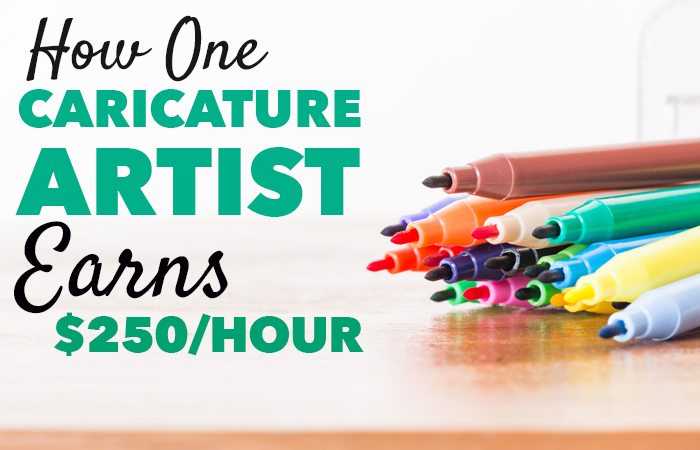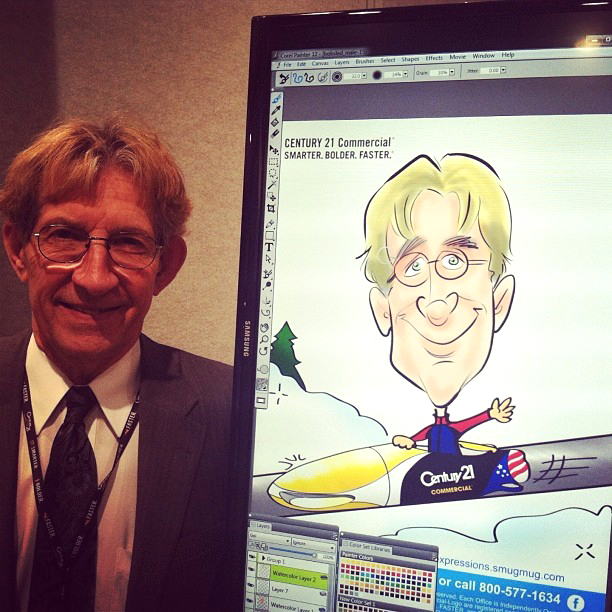
Five years ago, Julia Kelly earned $8.50 per hour as a caricature artist at an amusement park.
Today she charges $250 per hour for the same service.
“But … that’s just one or two hours a month, right?”
Guess again. Julia’s art business grosses more than $100,000 per year … and thanks to the power of hiring and outsourcing, she runs the company one day per week. Julia runs a part-time, six-figure business.
“Whoa.”
Yeah, dude. Double whoa.

Julia’s head contains an ocean of knowledge about hustling, focusing, and rebelling against mediocrity.
In the next 4,400 words, we’ll squeeze her brain onto the Internet, with the hope that her kick-awesome experience can benefit Afford Anything’s Rebel Nation.
The questions we tackle include:
- How the $%&!#$ did Julia multiply her income by 30x?
- Can we peek at a day in her life?
- How did she conquer limiting beliefs and shatter her scarcity mentality?
- What does she think about earning more vs. pinching pennies?
- Why does she only work one full day per week? How else does she fill her time?
- What income-skyrocketing advice can she offer to Rebels like you?
Let’s welcome Julia, a rebel who is generously pulling back the curtain to give us a behind-the-scenes tour of her six-figure hustle. Take it away!

We’re dying to hear about the leap from $8.50 per hour to $250 per hour, but let’s slow down and start at the beginning. How did you become a caricature artist?
I needed a summer job.
I had just started college in 2010, at age 22, after spending four years working and traveling. I had a part-time job as a graphic designer, but I wanted to make extra money in the summer.
I’d been doodling cartoons since I was a kid, so I filled out an application to work as an artist at an amusement park in San Diego.
They give you what amounts to six hours worth of classes — as kind of extended audition — before you get offered the job. So I had six hours of classes and then you graduate to full-blown artist with people paying $25 per head to have you draw’m.
The company policy was that you couldn’t do any pencil sketching. You had to draw the entire thing in marker so there’s no way to erase mistakes. Can’t erase mistakes + not secure in your skills = extreme stress. It’s trial by fire!
I worked at the park for three months and every day was terrifying. But the upshot is that it’s an extremely effective way to learn a new skill quickly.
After that summer I was a passable artist. But it probably took me about a year before I was really comfortable behind an easel. It’s all about time-on-task.
How long did it take you to transition from $8.50 an hour to $250 an hour?
I was getting paid $8.50 per hour at the amusement park. After that summer, I started looking for freelance gigs.
There’s a pretty dramatic leap in terms of what you can charge as a caricature artist when you switch to working for yourself. Right away I started charging $100 per hour to draw at parties and weddings because I saw that’s what other freelance artists were charging.
I moved up to a $250 hourly service a few years later when I started offering digital caricatures. When you can offer your clients something novel like digital caricatures that will really “wow” people, the perceived value of what you’re doing skyrockets.
I quit my part-time job as a graphic designer in May 2013. I’m coming up on two years of full-time self-employment. So far I’m digging it pretty hard.

How did you decide how much to charge?
I knew rationally that the market could pay these kinds of rates because I knew that’s what other artists were charging; the prices were written on their websites.
But my lizard brain made this a terrifying and emotional project. I actually thought people would get mad and offended if I charged this much.
How did you overcome that fear?
You accept that it’s going to be really damn uncomfortable the first dozen times, and then you just do it.
I would tell people my rate (usually over the phone) and then wince and hold my breath for their reaction. Nothing terrible ever happened. 🙂 The answer was either yes or no.
What advice would you give fellow artists on pricing their work?
Do competitor research. Who else is doing what you’re doing? Who is wildly successful at it? What are people paying for it?
Then reverse-engineer their success. You might have to work for free to get some testimonials or social proof to show your prospects, but once you have those testimonials, start selling.
You probably won’t be able to charge premium rates immediately, but keep improving your skills and moving up the value chain as fast as you can. Don’t stagnate at a lower rate or price than you’re worth.
Don’t make the mistake of thinking that you have to be confident in order to act confident and stand behind your rates. Assuming that you’re good at what you do, you will be worth it when you declare yourself worth it. Confidence in your rates is a skill that you have to practice to improve, just like anything else.
Have you struggled with self-doubt in relation to raising your rates?
Yep. There’s an imposter syndrome effect for sure, especially in the beginning.
But once I knew the value I was offering to my clients was approaching the same level as other artists in the industry (who were charging these rates), then it was just time to do it.
Was there ever a moment in your life when you doubted your decision to become an artist?
I don’t really consider myself an artist. I’m more of a business-minded freelancer who happens to know how to draw cartoons.
The business development/growth/management part of my business is more fun than drawing, so that’s what I spend my energy and focus on. Most of my books are on business. I own one book about art.
I struggle with some degree of fear in the back of my mind in relation to running a business in this industry. It’s not exactly what you’d call recession-proof. 🙂 And in comparison to the profession I’m actually trained for (accounting), it’s a lot less stable.
However, I have other sources of stability, like a good emergency fund and a fairly low cost of living (relative to southern California). This removes some of the risk of being in a business like this.

You’re attending school full-time. Why? Given that you’re already earning so much, why go to school?
Well, earning “so much” is relative. My business grosses over $100,000 per year in revenue, but I’ve got to pay my independent contractors, my assistant, and the myriad other business expenses.
But to answer your question, I’m studying undergraduate accounting. I know, it’s weird. I didn’t quite plan it this way.
I picked accounting because I like numbers and spreadsheets. Not kidding. I may be the only artist in existence who sincerely enjoys doing her own books and filing her own taxes 🙂
I started freelancing in my sophomore year. I thought I would work a gig here and there, earning a couple hundred extra dollars a month. I imagined that I’d graduate, take the CPA exam and get a nice corporate job at a Big Four accounting firm.
My motivation to progress along that route faded during my junior year, when my income from what is essentially a part-time business exceeded the salary I’d earn as a starting CPA.
Besides, once I got a taste of the sweet self-employed life, it’s a tough sell to go the corporate route.
However, I’ve spent years working on this degree and I’m finishing the damn thing. 🙂
My last semester ends in May 2015, and then I’m free to focus on my business full-time. I get misty-eyed with joy unspeakable every time I think about it.
What does a typical day look like for you?
Right now my typical day is mostly classes and homework. Upper division accounting classes are no joke. There’s generally one day per week where I can spend a whole day on my business. Here’s how that day generally goes:
I try to get the mentally-taxing work out of the way first. This is when I plan strategy, write sales copy, create processes for delegating work to my assistant, and make customer research calls.
After I get through that kind of work, then I turn to the busy work of answering emails, returning phone calls, and handling my books.
I used to answer all my own emails, send every contract, and create every invoice, but I got smart and hired an awesome assistant who handles all that stuff beautifully!
My mental bandwidth is totally gone by about 5 pm, which is why I start work as early as possible, so I can cut off at 5. I used to feel guilty about not being able to work late, but feeling guilty wasn’t making me any more productive in the evenings, so I just accept that I’m a morning person and that I’m functionally useless after 5 pm.
I work out with my trainer 3 days a week, and on the other days I rollerblade for an hour or so along the beach while I listen to podcasts or audiobooks. I live five blocks from the beach, which is glorious.
Then comes homework and easy work, like drawing commissions, while watching M*A*S*H reruns.
Then comes other evening stuff, like eating and flossing and playing with my phone and reading. And then sleep, glorious sleep! I really should get more hobbies – I keep telling myself I’ll get some once I finish school.
This is all assuming I don’t have a gig that day. If I’m supposed to appear at an in-person event, I’m driving, setting up, making fun of people’s faces, and then driving home. I spend a lot of time in the car, so I get hours and hours of quality podcast time.

You used to meticulously track your spending and be ultra-frugal. You’ve quit doing that. Why?
I think tracking spending is a healthy exercise and everyone should try it for at least a while. It’s especially important if you’re on a fixed income. If there’s a limit to your income, then tracking your expenses is the only way you can stay on-track with your saving goals.
I still stay mindful of my expenses, but at this point it’s a better use of my energy to come up with ways to grow my business than it is to track expenses down to the penny.
How has your quality of life changed since transitioning from pinching pennies to caring about value over price?
I fully endorse the Afford Anything philosophy: spend guiltlessly on what you love and cut back ruthlessly on the crap you don’t care about.
Case in point: I live with 1.5 other people (my best friend and her kid) in an 890 square foot apartment, which is furnished with mismatched free/Craigslist furniture. But I live on $5 lattes and I have a personal trainer.
Has the caliber of your clients changed since you started freelancing? Did you change your marketing efforts to attract big-league clients?
When I started freelancing it was all weddings and birthday parties. These are actually good clients to have and a lot of artists make a great living this way. There is a big difference though, between how much someone is willing to spend on their kid’s birthday party entertainment and how much a big company is willing to spend in order to get more leads at a trade show.
The big gigs are when I’m working with a company at a trade show. I draw caricatures in their booth, which serves as a great lead generator and gives the trade show attendees an awesome freebie — their caricature with my client’s logo on it. These are often multi-day events, compared to a standard two-hour birthday party.
I changed my marketing messaging to get these bigger corporate gigs. With private parties and weddings, it’s all about communicating how much fun everyone will have. With trade shows, the message is that caricatures will draw more attention to your booth and help you get more leads. Two totally different messages.
I think in many industries (certainly in mine), you can improve the “caliber” of your clients simply by selling to businesses instead of individual consumers. Businesses will pay more. I see it in my own life all the time; I can agonize over whether or not to get a $10 appetizer at a restaurant, but spend thousands of dollars for a new website with no degree of mental anguish whatsoever.
If you’re selling to individual consumers and you feel like you’ve hit a plateau, try repackaging your product or service and sell it to businesses.

You’ve made saving and investing a priority. What are your financial goals?
Financial independence, baby!
I used to be focused on a timeline and the exact date that I’d be financially independent from investments. But there are a lot of variables that I can’t control, like market conditions and the growth curve of my business. So I quit trying to figure out exactly when I’ll be financially independent and focus on the things that I can control, like my savings rate and avoiding a great deal of lifestyle inflation. A rough estimate has me hitting it probably around age 40 (I’m 27).
How can you demonstrate value to your clients?
Find out what is important to your clients, and then craft your messaging around it.
I learned this from my surrogate Asian father Ramit Sethi. His material on freelancing is some of the best out there. Here’s a truncated version of how to do it:
- Talk to your clients and potential clients. I’ve done this many different ways; coffee meetings, surveys, bribes with free caricatures, you name it. Find out what they care about when it comes to hiring and buying from someone like you.
- Take what you learned and craft it into your marketing messages. See all the sub-headers on my trade show page? These are the outcomes that my clients told me, over and over, are most important to them. I repeat these outcomes in detail when I’m on the phone with a lead. This is the stuff they care about. If you understand what they care about, making the sale is easy.
Ramit says it better than I can: “It’s really understanding the client’s hopes, fears and dreams … better than they understand it themselves. When you can do that, price becomes a mere triviality.”
You know what? Just go read his entire interview. I’ve gone back to this interview dozens of times. It’s a roadmap to getting into your client’s heads and communicating tons of value to them. Do what he says and prosper.
How did you transition from a scarcity mindset (making $8.50 an hour) to a position where you could hire others?
I’ve always struggled with the scarcity mindset — I still do to some extent. My big breakthrough came last year during a conversation with Ramit. I had hired some sporadic administrative help here and there, but I wasn’t utilizing a proper assistant because I was worried about what a “big expense” it would be.
Ramit looked over my revenue numbers, monthly expenses and cash cushion and basically said, “Quit being a damn coward! You can afford this! Hire more help!”
So naturally, I resolved to quit being cowardly. I put a detailed ad on Craigslist, got some top-notch applicants, put them through a lot of testing and interviews and ended up with an amazing assistant. She works remotely about 60 hours per month and handles all my contracting, invoicing, scheduling, email follow-up, contact management, etc.
Once I delegated to her, I realized how much time I had spent doing repetitive work that was keeping me “busy” but not productive. She keeps my business humming in the background and allows me to focus on big wins. I will never go back to not having an assistant; she’s paid for herself many times over.

You now have a team of artists working under you. Was it a challenge to assemble this team? What made you decide to expand?
It happened organically. You get an inquiry here and there for a gig that you can’t schedule, so you ask around to your network (the caricature community is pretty small) and you subcontract the gig out.
I don’t think there was ever a point where I officially “decided” to expand. I just kept getting gig requests and couldn’t handle all of them. I work with three or four artists here in San Diego, and others in L.A., Vegas and a few other states on occasion.
The artists I hire are professional and easy to work with. I haven’t run into any significant issues; they’re an awesome crowd. We all work for each other; we subcontract gigs back and forth all the time.
What has been the biggest hurdle you’ve faced in your business (aside from raising your rates)?
It’s not a recurring revenue model. The majority of the time you get hired once — for one trade show — and they’ll want to do something different next year. Weddings and parties are the same, kind of a one-and-done thing.
I have a decent number of repeat clients that hire for multiple shows or that hire for the same shows every year, and I have increased this type of client year-over-year. But every month you’re starting from zero. It’s a constant hustle to get new clients and while hustling is good for the soul, I prefer a more predictable revenue stream. There are definitely ways to achieve this, and I’m going to pour my attention into this goal in the coming months.
What’s the most rewarding thing about working for yourself?
Freedom to decide how I spend my time is the most rewarding aspect. The tax deductions are a close second.
Tell us about your work-life balance?
Heh, the only other thing I can focus on, at this point, is school. This will change in May when my higher education journey through Mordor adventure comes to a close.
Business will get my full-time attention and that will be freakin’ rad. I also have high hopes about picking up some hobbies. Once I actually get a work-life balance I’ll update you on how it’s going. 🙂
Your website says caricatures can be drawn fairly quickly. Have you had to work on being more efficient over time? Have you struggled with being a perfectionist?
When you’re drawing someone live, you learn from day one that you cannot be a perfectionist. If you are, you’ll be drawing the same person for hours. I learned to be pretty fast right from the start because when you’re working at a theme park, you’re mostly drawing little kids and little kids tend to dislike sitting still.
I believe that people have the best experience when they can get their caricature quickly and not spend the whole party/reception/conference standing in line to get drawn. So I’m always trying to get faster without sacrificing a good likeness. It’s a balance; if you go too fast you start to produce the dreaded “stamp drawing” where everyone looks the same. To commit this cardinal sin is to invite shame and disgrace upon yourself within the caricature community.
Have you ever experienced an unhappy client? How did you handle it?
Two years ago I screwed up the dates for an anniversary party. I accidentally marked it on my calendar as happening on Sunday when it was actually happening the night before. I got an extremely angry call from the client the next morning. Everyone had been looking forward to it and it was meant to be one of the big attractions of the party. Basically your worst-case scenario here.
She didn’t want to hear anything from me over the phone, she wanted to express how angry she was and then she hung up. She was very justified; I had screwed up royally.
I tried calling her back but she wouldn’t pick up, so I immediately emailed her with an apology. When you screw up like that you just accept full responsibility, make no excuses, and agree how justified the client is with being angry. Then I had a massive $200 gift basket sent to her address with another apology note.
Huge lesson learned on my part; now I have strict systems in place to make sure that never happens again. That was the worst one by far, but I have had other varying degrees of angry clients and I always try to handle it the same way: accept responsibility, don’t make excuses, and make it right.
Here’s the weirdest thing: I never heard from my angry client again until today, literally. Two years after this fiasco she emails me out of the blue and just booked me for two different events. I guess the apology took. 🙂
On your website, there are 3 packages at 3 different price-points. This is a sales tactic commonly recommended for small businesses. How has it worked for you?
Packages #1 and #2 are two types of services: traditional pen-and-paper caricatures and digital caricatures. You can charge twice as much for digital caricatures because they’re novel, techy, and more of a value-add to the client.
The third package (the most expensive one) utilizes rudimentary sales psychology. Package #3 doesn’t tangibly exist. If someone ordered that package I would 100% deliver on it, but so far no one has. The point of Package #3 is to make Package #2 look like a more economical choice. This is a basic price anchoring tactic. I’d recommend it as long as you can ethically and actually deliver on the expensive option.
What are you currently doing to grow your business?
Right now I’m focusing on two things:
- Getting referrals. By that I mean putting together a referral system that runs on its own. I’ve lost a ton of potential business because I was haphazard about referrals and didn’t have a system. I’m implementing the advice in The Referral Engine by John Jantsch.
- Getting better at sales. We think we need more leads and prospects, but what’s more likely is that we need to be better at converting our existing leads into sales. I’m working on creating phone scripts and presentations, tweaking my follow-up system, and learning how to more effectively close a sale. This is my weakest point because I’m naturally introverted, but I’m getting better at it.
What’s one piece of advice you wish someone had told you when you first started out, still earning $8.50 an hour?
Get used to being uncomfortable.
I was extremely uncomfortable for a whole year before my skills got good enough for me to be relaxed behind an easel. It was uncomfortable to pitch and make sales, charge higher rates, learn digital caricatures, hire people, invest in business courses, and expand into new cities.
Accept that any time you’re making significant strides of progress, you’re probably going to be very uncomfortable in that moment. Be cool with that.
Do you still struggle with limiting beliefs? How do you keep pushing yourself forward?
I have limiting beliefs coming out my ears, believe me. I’m not sure those will ever go away, because as soon as I reach one milestone in my business I set my sights on a new one, which comes with a whole new set of limiting beliefs.
Here’s how I keep myself pushing forward. This is probably the most valuable lesson I’ve learned in the last couple of years:
When I’m stuck, unmotivated, scared, confused, whatever, I have never come up with a solution sitting alone at my computer doing Internet “research” on my problem. Ever. I find the solution by going external.
What does going external mean? Get outside input. Go talk to a mentor or even a competitor. Have a real conversation with someone you trust. Buy an hour of an expert’s time on Clarity. Email whatever famous author/blogger/entrepreneur you admire and tell them your problem (be brief and make it a good email, or you won’t get a reply).
I’ve done all these things. You will get input from them that’ll help you look at your problem in a new light.
I’m shocked at how often what seems like a huge issue shrinks down to something manageable with just a tiny shift in perspective, and that shift in perspective almost always comes from outside input. I don’t know where my breakthroughs are going to come from, but they’re certainly not going to come from a vacuum in my own head or from wasting time on Internet “research.”
Do you see yourself helping fellow artists break out of the “starving artist” mindset and charging what they’re worth?
I hope this interview will help! I haven’t gone about it in any kind of formal way but I try to help other artists and freelancers who ask for advice. If anyone reading this has a question, feel free to email me ([email protected]) or leave a comment.
What are the sources of inspiration you’ve drawn on in your work?
My inspiration comes from podcasts and books. Here are my favorites off the top of my head:
- Mixergy. The Cadillac of business podcasts. Andrew Warner gets into it deep with his guests with exhaustively well-researched interviews.
- Growth Bytes by Eric Siu. It’s a series within his regular podcasts. Short little episodes which have given me tons of ideas to implement and tools to use.
- Eventual Millionaire. Really high caliber interviews, which you’d expect from millionaire entrepreneurs.
- Street Smarts. Excellent book by Inc. Magazine columnist Norm Brodsky on the fundamentals of business broken down into real-life case studies.
- The $100 Startup was my bible in the early days of freelancing. Incredibly inspirational for a budding freelancer.
- Also, just Google “Ramit Sethi freelancing” and you will get a veritable treasure trove of both inspirational and actionable material.
[Final Thoughts from Paula]:
Wow, what a kick-awesome success story! Thank you, Julia!
Little-known fact: I also used to work at an amusement park. I earned $6 per hour (although if I remember correctly, I think I snagged a raise up to $6.50 per hour after a few months). I was the classic carnie, standing at a game booth, speaking into the microphone: “Step right up! Just $2 to play, there’s a winner every time!”
I love Julia’s story because I can imagine the experience of being an amusement park employee, earning $8.50 per hour, enjoying the work but feeling frustrated by the low pay.
The Conformist Majority would capitulate to that feeling of helplessness. They’d complain that their troubles are imposed onto them by the outside world.
Julia, by contrast, took matters into her own hands. She embraced an abundance mindset. She confronted her limiting beliefs. She took action, in spite of her fears. She’s not afraid to call herself a coward, and that makes her brave. Bravery gets rewarded; fortune favors the bold.
I also love that she disrupts the myth of the starving artist — another limiting belief we must rebel against. If you call yourself “starving,” you will be. Flip that script.
Check out Julia’s digital caricature artist website, and drop a note in the comments if you have any questions for her!
